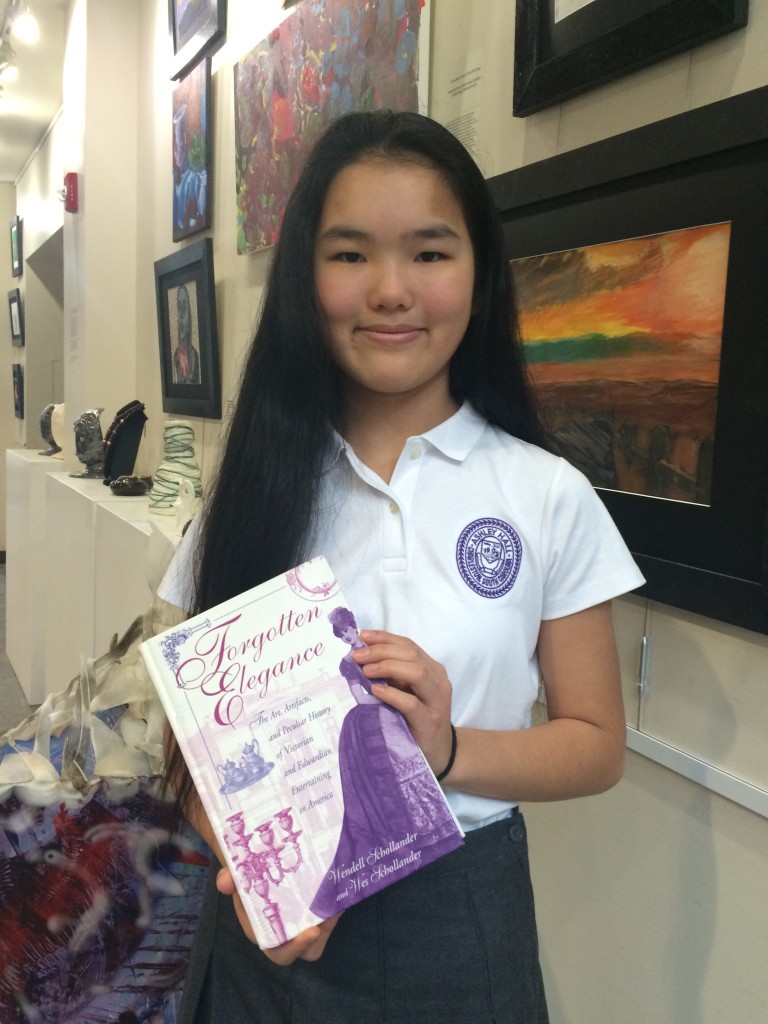During the Gibbes Museum renovation, we’ve taken our Junior Docent program on the road! Several local institutions, like the Charleston Museum, have helped out by providing rich resources for students to research and a venue for them to present their findings. Two Ashley Hall students share their experiences with this program, here and in the previous post.
In the very last week of October 2015, the whole seventh grade at Ashley Hall was gathered together. Our English teachers stood at the front of the room, about to assign our second quarter project. Once everyone was situated, they started speaking.
We were going to explore more about Charleston’s history. To do so, each of us would be assigned to research a different aspect of our city’s history. To that end, we would write an informative essay on the topic we were assigned, and prepare an oral presentation to give at the Charleston Museum.
I was assigned the topic “suppertime in the Lowcountry during the mid-19th century.” I started by finding reliable sources to use for research. I ordered a book entitled, Forgotten Elegance, written by Wendell and Wes Schollander, and went to the Historic Charleston Foundation to gather information on my topic. It was interesting to learn about the ingredients, such as turtle, that people in the 1800s in Charleston, South Carolina, would use in their recipes; and the silver pieces they would decorate their tables with.

Halfway through November, my English class took a trip to the Charleston Museum. We listened to Pat and Elise, the Gibbes museum docents, as they spoke about the history of Charleston. We observed how they engaged, educated, and entertained their audience. We were then led around the museum, finding which glass case we would stand before to give our speech. I was to speak in front of a case filled with beautiful silver flatware and pitchers, similar to what would have decorated a dining room table in the Lowcountry during the 1800s.
Finally, it was the second week of December—exam week. Tuesday morning rolled around, and I found myself standing in the lobby of the Charleston Museum. I was so nervous to give my speech. It would only be in front of half of my class and their parents, yet still I had butterflies in my stomach. Once everyone arrived, my classmates and I lead the group upstairs. Two girls introduced our assignment, and then people started to present.
When the student before me started giving her speech, a group of elementary school children entered the museum. They made quite a racket, speaking to each other and pointing at things in the glass cases. I felt bad for the girl who was speaking, as she had a loud group in the background, and hoped that the children wouldn’t drown out my presentation.
After what seemed like ten seconds, but was really five minutes, it was my turn to speak. I had to lead parents and my teacher to the section of the museum where the silver flatware and pitchers were located. I walked ahead of the group, but was nervous that I wouldn’t be able to find the right glass case. Doubt crept into my mind, and I felt anxious. I had only been shown where it was once, and that had been a month ago.
I did, however, find the right place with ease. Once I saw the shining silver pieces reflected in the glass case in front of me, I knew I was in the right place. It felt like one heavy weight was lifted off of me, and the second one would be gone after my presentation. I started to talk, but the elementary children had followed us, and I could barely hear what I was saying, so my audience probably couldn’t either! I tried to speak up, but I have a quiet voice, so I found it hard. I felt like I was screaming over echoing sounds of excited school children!
Soon, it was time for me to conclude my speech, and I introduced the next girl who would speak. She lead us over to another part of the museum, and I finally felt relieved. It was all over! I had finished my presentation, my paper was turned in weeks beforehand, and I could relax.
Following the holiday break, my class received our badges in English class. They had our names on them with the words, “Junior Docent.” My experience as a junior docent was very nerve-wracking, but fun at the same time. I enjoyed learning about Charleston’s culture and history while working on my assignment. At the museum, I learned many new and interesting facts about Charleston, as well. I feel very lucky to have been given the opportunity to practice orally presenting at the Charleston Museum.
—Mia Lassiter, 7th grader at Ashley Hall and a Gibbes Museum Junior Docent
Above: Silver objects from the John C. Rivers Collection at the Gibbes Museum of Art.
Published February 25, 2016

